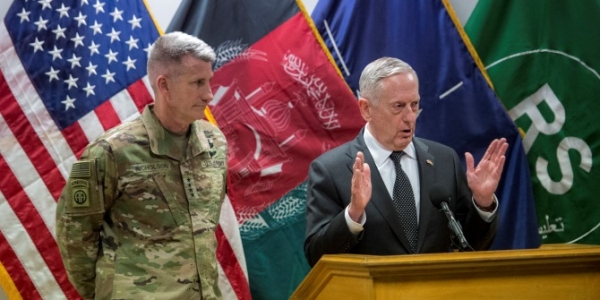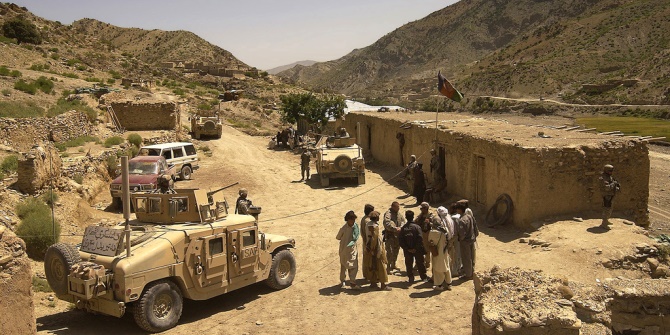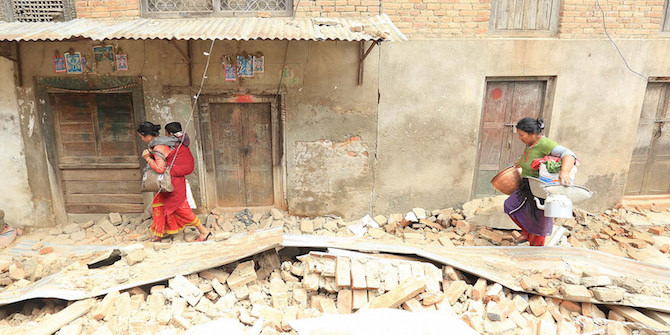Ahead of the critical NATO Summit in Belgium on 25 May Dr Sajjan Gohel discusses the security conditions and challenges in Afghanistan which have been exacerbated by the emboldened Taliban who now control more territory in Afghanistan than at any time since October 2001. He also outlines proposals by U.S. General John W. Nicholson Jr. to stem the deterioration, contextualising why the political and military decisions made by NATO leaders in 2017 could well decide Afghanistan’s future direction in what remains one of the longest protracted conflicts in the world.
Part 2 of Dr Gohel’s analysis, on the challenges posed by Haqqani Network and the ISIS-affiliated Wilayat Khorasan and the geo-strategic agendas of Afghanistan’s neighbours, is available here.
On 21 April, 2017, ten men wearing the uniform of the Afghan National Army (ANA), returning from what seemed to be the front lines against the Taliban and carrying the bodies of wounded comrades entered the base of ANA’s 209th Corps in Balkh Province, in northern Afghanistan, regarded as one of the safer parts of the country. Upon passing several checkpoints in the base, they came across hundreds of unarmed soldiers who were emerging from Friday prayers and preparing for lunch. However, those ten men were not from the ANA, but in fact part of the Taliban, who had been sent on an insidious fedayeen mission, in effect to kill as many Afghan soldiers as possible whilst dying in a hail of bullets. For several hours, the Taliban fighters unleashed carnage, some as suicide bombers, killing 150 Afghan soldiers and thus setting the unpalatable record of inflicting the deadliest single attack in one day against the military.
Soon after taking ownership for the base attack, the Taliban also officially announced its 2017 Spring Offensive which they claimed will be conducted with a dual political and military approach with the main focus on foreign military forces. ‘Operation Mansouri’ is named after Mullah Mansour the previous Taliban leader who was killed in a U.S. drone strike in Pakistan in May 2016. The offensive is a clear statement of intent by the Taliban to target Afghan and U.S. forces and will also likely see the Taliban initiate large-scale coordinated raids as well as laying mines and IEDs across Afghanistan’s road infrastructure to obstruct the mobility of military carders and cut off access to resources. This scenario contributes to the already gloomy outlook for Afghanistan and it is another sign of a tough year ahead for Afghan President Ashraf Ghani.
Adding to the instability is the return to Kabul of Afghan warlord Gulbuddin Hekmatyar, who was once part of the insurgency. Hekmatyar signed a peace deal in 2016 but remains one of the most divisive figures in Afghan politics, and his reputation of regularly switching sides to suit his convenience will concern other political factions that President Ghani is struggling to keep together.
A comprehensive political settlement keeps being suggested as the answer to all of Afghanistan’s problems. The Quadrilateral Coordination Group (QCG) involving the U.S., China, Pakistan, and Afghanistan was created to advance an Afghan-led peace process and talks with the Taliban. The QCG failed to achieve this with the Taliban refusing and unwilling to part from violence. Aside from the talk about negotiations, no one has ever identified what those negotiations should entail, partly because it is difficult to assess what the Taliban’s actual demands would be. Equally, the Taliban has never renounced al-Qaeda, or abandoned its medieval and misogynistic views towards women. In fact it is hard to see what middle ground there is to engage meaningfully with the Taliban whilst they murder Afghans and seek to kill Western troops. Eventually, in May 2016, the U.S. grew weary and concerned about the Taliban’s true intentions and authorised a drone strike on the then head of the Taliban, Mullah Mansour, when he was travelling from the southern Iranian town of Mashad to Quetta in Pakistan.
Despite the loss of Mullah Mansour Taliban fighters have gained more territory across the countryside over the last two years and now threaten several cities. In March 2017, the Taliban captured Sangin in Helmand province. They had already occupied swathes of Helmand but the fall of Sangin is a watershed moment highlighting its growing strength in the south. Of the province’s 14 districts, only two are solidly under President Ghani’s control. Many sacrifices have been made in Helmand. British troops died protecting Sangin during its combat mission there and hundreds of Afghan security forces have also been killed across Helmand in recent fighting.
As a result U.S. Marines have been forced to return to Helmand, two years after leaving. They will primarily train and act in an advisory role to Afghan forces but they could also be asked to take a combat role. It may well come to that, especially as the Taliban attempts to wage an assault on Helmand’s provincial capital, Lashkar Gah. Despite the south of Afghanistan being the Taliban’s traditional powerbase, it is not the only area where it is establishing a growing presence. In May, 2017, the Taliban captured Qala-e-Zal district in the northern province of Kunduz.
Afghanistan’s forces are enduring an alarming amount of casualties. More than 6,700 lost their lives in 2016 and have suffered a 2.4% attrition rate every month. Civilian casualties have attained an undesirable record too with 3,498 deaths and 7,920 injured in 2016 alone. Some of this was inflicted by Wilayat Khorasan. Afghanistan cannot deal with these challenges and threats on its own. That obviously means the U.S. and its allies once again being required to militarily assist Kabul.
U.S. troops have been in Afghanistan since October 2001, primarily as part of an International Security Assistance Force (ISAF) force that peaked in 2010 to nearly 100,000. However, then U.S. President Barack Obama advocated a 99% reduction of U.S. troops after 2015. Obama wanted to rapidly end the war in Afghanistan, but there is a big difference between ending a war and withdrawing from one. Obama assumed that a quick withdrawal of U.S. forces and setting an exit timetable would help initiate a peace process between the Afghan government and the Taliban. As results have now painfully illustrated, the reality has been quite the opposite. Gains soon became loses.
A premature exit strategy as well as a rushed and ill-thought out arbitrary deadline for U.S. withdrawal from Afghanistan was never going to help to end the war. Conversely it assisted the Taliban’s war of attrition. It is worth recalling that old adage, “The West keeps looking at their watch, but the Taliban is the timekeeper”.
Looking at the past, a premature extraction from Afghanistan will not make it a safer place, but rather a safe-haven for terrorists, extremists and misogynists. In the 1990s the West abandoned Afghanistan, which then became a cesspool for international terrorism led by al-Qaeda. These factors eventually culminated in the September 11 attacks in 2001.
A new (last) hope?
In another indicator of how badly Afghanistan is faltering, the U.S. commander of the Resolute Support Mission in Afghanistan, General John W. Nicholson Jr. has requested additional troops to halt a deteriorating situation with the Taliban and to assist in training Afghan security forces. Nicholson himself is now intrinsic to stemming the deteriorating situation in Afghanistan and a potential last hope.
Since 2002, Nicholson has completed four tours to Afghanistan and knows the country better than most. Some years ago, he took the unusual step of officially apologising to the Afghan families killed and injured by U.S. Marines during an incident in Shinwar, Nangarhar Province in 2007, because he argued keeping civilians on-side of the U.S-led coalition was essential in combating the counter-insurgency in Afghanistan.

Nicholson believes that the present level of 8,400 U.S. troops in Afghanistan is insufficient. There is a shortfall of a few thousand. Nicholson wants to go on the offensive and with a troops surge, break the impasse between Afghan forces and the Taliban, Haqqani Network and Wilayat Khorasan. Nicholson’s operational idea is to capitalise on the Afghan forces that have shown strong capability to withstand and push-back against the Taliban, in particular the Afghan Special Security Forces (ASSF) and the Afghan Air Force (AAF). He wants to grow the ASSF and AAF, working with a U.S. Marine Expeditionary Brigade, to build an offensive capacity against the Taliban.
There were marked tactical gains during the increase of forces between 2010 and 2011, but they did not break the strategic stalemate because of the lukewarm support by the Obama administration who announced the withdrawal timetable, in advance, for the Afghan campaign. The other problem is Afghanistan’s neighbour, Pakistan, continuing to provide sanctuary and support which is an obstacle to success in Afghanistan.
Nicholson’s plan calls for ‘strategic patience’ by implementing a more focused strategy, involving a civilian-military integrated approach for the vulnerable districts across Afghanistan. This would entail seeking to reverse the Taliban momentum, isolate the threat away from the people, connect the people to the government, help the government to build capacity and eventually transfer responsibility to the local administrations in those districts. General Nicholson believes the U.S. cannot afford to walk away from Afghanistan otherwise it will serve once again as a launch pad for terrorists globally.
Importantly, Nicholson knew Ashraf Ghani before he became the Afghan President. He had read a book by Clare Lockhart and Ashraf Ghani, Fixing Failed States: A Framework for a Fractured World, and subsequently met Ghani to discuss Southern Afghanistan and what needed to be done there.
U.S. National Security Adviser General H. R. McMaster is currently overseeing the Afghanistan review and has travelled to the country to make an assessment on what the Afghan mission should entail. In 2010 McMaster was Commander for Planning, at ISAF Headquarters in Kabul. He too has a strong grasp of the ground realities in Afghanistan and is respected across the political divide for his role in Iraq between 2005 and 2006, where he led the pacification of Tal Afar in Southern Iraq, a success that formed part of the blueprint for the surge strategy in 2007. But as to how far Nicholson’s proposal is adopted, will be discussed at a NATO meeting on 25 May in Brussels, Belgium, making this a critical moment for the future of Afghanistan.
Part 2 of Dr Gohel’s analysis, on the challenges posed by Haqqani Network and the ISIS-affiliated Wilayat Khorasan and the geo-strategic agendas of Afghanistan’s neighbours, is available here.
This article gives the views of the author, and not the position of the South Asia @ LSE blog, nor of the London School of Economics. Please read our comments policy before posting.
About the Author
Sajjan Gohel, PhD is International Security Director at the Asia-Pacific Foundation, Senior Advisor to the multilateral Partnership for Peace Consortium’s Combating Terrorism Working Group and a Visiting Teacher in the International History Department at the LSE. Read his previous South Asia @ LSE posts here.







